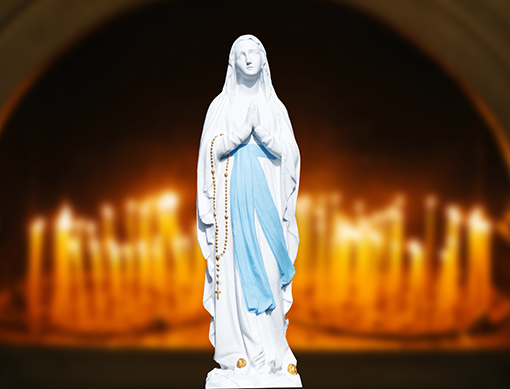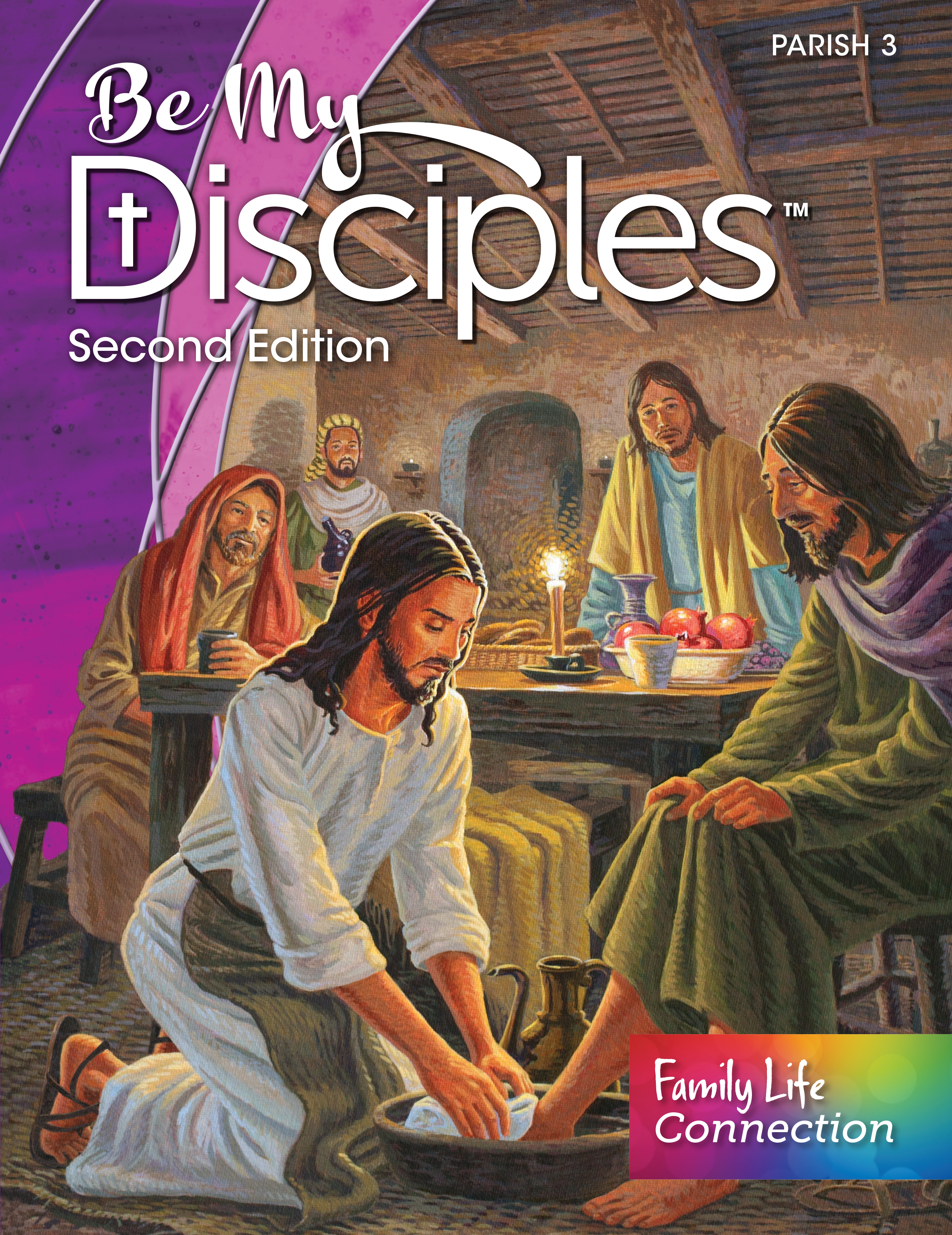A number of years ago, during an audience with members of Italy’s National Federation of Farmers, Pope Francis stressed the important vocation of caring for the earth which provides for all of humanity.
 He said, “Care of the earth, making alliance with it, in order that it may continue to be, as God wants, the source of life for the entire human family.
He said, “Care of the earth, making alliance with it, in order that it may continue to be, as God wants, the source of life for the entire human family.
The Holy Father was speaking of the vocation of farmers, something we don’t often consider, referring to it as a true vocation which deserves to be recognized and valued.
He encouraged listeners to "rediscover love for the earth as 'mother' – as Saint Francis would say – from which we have taken and to which we are called to constantly return."
Many of the faithful, especially our youth, may not realize that we have, among our saints, a farmer.
The simple, hard-working life of St. Isidore, the farmer, is a life of important lessons for us as followers of Christ.
St. Isidore was born in Madrid, Spain, around 1070 A.D. into a devout family that prayed to and worshipped God and were concerned about the poor. As an adult, Isidore worked for a wealthy landowner, farming his fields and taking care of the land and the animals.
Isidore, who made time for Mass every day before beginning his work and adopted the practice of praying as he plowed, was known for this generosity and care for the poor, making sure they had enough to eat, even though he was poor himself. He also showed a great love and respect for the animals in his charge and for the soil that grows all things for life.
Legends say that Isidore’s coworkers complained he was often late for work because he made time for Mass first, but when the landowner went to check out the complaints, he found two angels plowing the fields until Isidore’s return from Mass, and he also noticed two angels often plowing alongside of Isidore so he often did double the work he was expected to do.
Stories of miracles followed Isidore throughout his life, and after his death, attributed to his devotion to prayer and the Eucharist. Among them was his ability to help the many beggars he brought home to his wife, who fed them from an unending pot of stew.
In addition to teaching us about the love and care for God’s creation, the dignity of manual labor and happiness that is possible with a simple life, St. Isidore shows us that sainthood is not reserved for the learned, or the religious, but is the achievable goal of every person no matter what their position in life. He died May 15, 1130, and declared a saint in 1622 with well-known saints Ignatius of Loyola, Francis Xavier, Teresa of Avila and Philip Neri. In Spain, the group is known as “the five saints.”
Children may have the idea that prayer is something we do in a certain way, at a certain time and with certain words. How can we teach students the lesson of “praying when we plow?”
Stress prayer is communicating with God, as a father and a friend. No special words or times are needed, and, in fact, saints teach us to talk with God while we are working, going to school, doing chores and playing.
Help children learn to talk about anything with God. Ask children what kind of things they would like to talk to God about. For example, if children are fearful of something, like going to bed in the dark, or struggling with something like jealousy of a sibling, or conflicted about something, like following a friend in making a bad decision, what would they say to God or ask God to do for them?
Set an example. Share your practices of praying, perhaps while you are creating lesson plans, cooking a meal or doing yard work. You may recite known prayers, or just chat about your day or your worries with God. It’s all prayer.
Remind them of Jesus’ words. “Let the children come to me, and do not prevent them; for the kingdom of heaven belongs to such as these” Matthew 19:14. Just like children go to their parents, or grandparents, or share things with their friends, Jesus invites children to come to him whenever they want to, to say hello, to ask for guidance, to ask for protection, or simply say thank you.
For teachers: St. Isidore is the patron saint of Catholic Rural Life. The prayer that follows is an excerpt from a 9-day novena to the saint which appears on their website:
O Lord, as You have made the earth,
To man and beast have given birth,
Have given sun and rain that thence
The soil might give them sustenance:
We beg You make us willing to
Perform the law we get from You
That work of ours and grace of Yours
May bring the increase that endures.
Through Jesus Christ let this be done,
Who lives and reigns, our Lord, Your son,
Whom with the Spirit we adore
One God with You forevermore.
 About the Author
About the AuthorMary Clifford Morrell, mother of six and grandmother to ten, is a Catholic journalist, editor, and author who has served the Dioceses of Metuchen and Trenton, New Jersey; Burlington, Vermont, and RENEW International in the areas of religious education and communication.
What was your first job? What lessons did you learn from doing it? I remember my first job was in the billing office of my uncles’ lumberyard. I learned that words, not numbers, are my strength! I became a religion teacher.
 We know that any work has multiple benefits. Catholic teaching says work is more than a way to make a living; it is a form of continuing participation in God's creation, described in Genesis 2:4-5. The Catechism tells us, “Work is part of the original state of man and precedes his fall; it is therefore not a punishment or curse.” (Compendium, p. 256). Work is a participation in the creation of God. Faith formation lessons can shape our students’ attitudes about the work they will do when they enter the working world.
We know that any work has multiple benefits. Catholic teaching says work is more than a way to make a living; it is a form of continuing participation in God's creation, described in Genesis 2:4-5. The Catechism tells us, “Work is part of the original state of man and precedes his fall; it is therefore not a punishment or curse.” (Compendium, p. 256). Work is a participation in the creation of God. Faith formation lessons can shape our students’ attitudes about the work they will do when they enter the working world.
On May 1, the Church celebrates the feast of St. Joseph the Worker, who was a carpenter by trade. Celebrating the work that Joseph did to support his family helps us to remember to pray that God watches over all workers and protects them from accidents. We honor St. Joseph the Worker when we respect and appreciate all workers.
Pope Francis has said the fact that St. Joseph, as well as Jesus, practiced carpentry reminded him "of all the workers in the world, especially those who do grueling work in mines and factories" as well as "those who are exploited through undocumented work." Workers have the right to fair wages and safe working conditions. "Earning bread is what gives you dignity and if we do not give our people, our men and women, the ability to earn bread, this is a social injustice in that place, in that nation, in that continent," he said.
Essential Tools. Ask students to identify some kinds of work they see people doing in their community. They may list teachers, landscapers, bus drivers, police officers, builders, store clerks. Ask them to mention work that their own family members do. After you have a list, ask what kinds of tools each worker needs to do their work well. Finally, remind students that all workers also need God’s grace and protection for their work. Reflect together on the beginning of Psalm 127:
Unless the LORD build the house, they labor in vain who build.
Unless the LORD guard the city, in vain does the guard keep watch.
It is vain for you to rise early and put off your rest at night,
To eat bread earned by hard toil—all this God gives to his beloved in sleep.
Praying for Workers. “St. Joseph, you showed us the dignity of working to support your family. Protect all workers in their daily tasks and defend them from becoming discouraged. Inspire all who are responsible for workers, employers and government leaders, to guard the safety and rights of all who work. Help unemployed people to find satisfying work. May we learn how to best use your talents for the good of all. Amen.”
 About the Author
About the AuthorDr. Lauri Przybysz specializes in equipping families to live their vocation to be domestic churches and signs of God’s love. Lauri received the Doctor of Ministry from the Catholic University of America, and she has been both a Catholic middle school religion teacher and a faith formation coordinator at the archdiocesan and parish levels. She is the mother of six children and grandmother of 21.
At the wedding feast at Cana, she told the servants, “Do whatever he tells you.” This is her guidance to us, too. When he was on the cross, Jesus introduced Mary to us as our mother. She knows her Divine Son better than any other person does, and she is our reliable advisor on how to follow him. As our mother, Mary will help us. This month, learn more about her and ask her to pray for us to love Jesus even more and follow him with open and sincere hearts. Invite your students to get to know her better.
 During the month of May, we remember our own mothers, too. Mary teaches us to look kindly on mothers. Whatever challenges mothers have experienced, all can rely on their Spiritual Mother to be at their side. May we come to better understand our mothers, their gifts and limitations. May we grant ourselves the same mercy when we are less than perfect.
During the month of May, we remember our own mothers, too. Mary teaches us to look kindly on mothers. Whatever challenges mothers have experienced, all can rely on their Spiritual Mother to be at their side. May we come to better understand our mothers, their gifts and limitations. May we grant ourselves the same mercy when we are less than perfect.
Pope Francis said recently that we have a super-Mother in Mary: “Honoring our Heavenly Mother would be to promise her that we will practice her virtues of Faith, obedience, purity and humble service. In this way, we will be trying to become the saintly sons and daughters of our Heavenly Mother, the holy Mother of God.” Long before our Church leaders officially declared Mary the Mother of God, her cousin Elizabeth knew what a special privilege Mary had been given. When Mary went to visit Elizabeth, Elizabeth called her “the mother of my Lord” (Luke 1:43).
Our Other Mothers. This month, remember women who showed you a motherly care. Think of a woman that taught you a new skill or introduced you to a new book or idea. She may have been the mom of your school friend or the coach who took you under her wing. Consider sending her a note of thanks.
Mary, Our Role Model: Mary exhibited the fruits of the Holy Spirit, qualities we all hope to demonstrate: love, joy, peace, patience, kindness, generosity, faithfulness, gentleness, self-control (Galatians 5:22-23). Ask students to describe actions that show these fruits in a person’s life.
Calling Upon Mary. We ask Mary’s intercession in all the forms of Marian prayer we say. Have your students memorize one of these prayers: the Angelus, the Regina Caeli, the Hail Holy Queen, the Memorarae.
Mary Was There with Jesus. Say the Rosary as a class, meditating on the Joyful, Sorrowful, and Glorious Mysteries. Show how Mary is a featured person in each mystery. Invite the students to imagine themselves standing beside Mary in all the events of Jesus’ life.
We Are at Home with Mary. Mary inspires us to recognize the closeness and comfort that God offers us. Artists like to depict Mary in the likeness of a woman from their own cultures. Look for images of Mary from Japanese, African, and Native American artists. Ask students to describe how Mary would look if she lived in their neighborhood.
 About the Author
About the AuthorDr. Lauri Przybysz specializes in equipping families to live their vocation to be domestic churches and signs of God’s love. Lauri received the Doctor of Ministry from the Catholic University of America, and she has been both a Catholic middle school religion teacher and a faith formation coordinator at the archdiocesan and parish levels. She is the mother of six children and grandmother of 21.
One morning, while I was sitting in the parking lot of a lovely church at the Jersey shore, I noticed a lovely statue of Mary in the garden directly in front of my car. I had never seen anything like it before. There was something about her face that drew me. Upon closer examination I saw that the statue was titled, “Our Lady of the Smile.”
 Immediately, I smiled. I wondered how many others had that same reaction, and I marveled that I had never heard of this title of Mary before. I wondered where this title originated and imagined there must be many other titles of which I was unaware.
Immediately, I smiled. I wondered how many others had that same reaction, and I marveled that I had never heard of this title of Mary before. I wondered where this title originated and imagined there must be many other titles of which I was unaware.
A little research led me to the story of St. Therese of the Child Jesus who was critically ill as a young child and, doctors feared, close to death. A family statue of Mary as Our Lady of Victory was in the room and Therese’s sisters knelt to pray for her recovery.
In her autobiography, “Story of a Soul,” St. Therese, the Little Flower, writes, “All of a sudden the Blessed Virgin appeared beautiful to me, so beautiful that never had I seen anything so attractive; her face was suffused with an ineffable benevolence and tenderness, but what penetrated to the very depths of my soul was the ‘ravishing smile of the Blessed Virgin.’ At that instant, all my pain disappeared, and two large tears glistened on my eyelashes, and flowed down my cheeks silently, but they were tears of unmixed joy. Ah! I thought, the Blessed Virgin smiled at me, how happy I am…”
As the story was shared, devotion to Our Lady of the Smile grew.
The Marian month of May is a wonderful time to help children to get to know Mary, who is beloved and honored all over the world. They may have wondered, like me, why she is called by so many titles and what they mean.
While some of her titles are officially accepted by the Church, others are the result of pious tradition. All are meaningful.
The All About Mary website at Dayton University explains that among the reasons for her varied titles are:
She is a person. And as a person, descriptions of her are unlimited. “As individuals we are ineffable, meaning nobody – except God – has the last world on who we are and may become.” Certainly, that is true of Mary, of all people! And I love that description of an individual, something so important for children to know – they are not limited in who they may become. Many of Mary’s titles reflect her character and her roles – Mother of God, Queen of Peace, Star of the Sea, Queen of the Angels, Seat of Wisdom.
She is our intercessor. Since ancient times, the faithful have gone to Mary with all their needs, and, as human beings, our needs are many. Many of her titles reflect her role in giving us aid and maternal care, such as Our Lady of Comfort; Mary, Help of Christians; Mother of the Poor, Untier of Knots, and Mother of Mercy.
She belongs to all places and cultures. Mary is so loved in all parts of the world and by people of every race and culture, that it’s no surprise she bears titles that identify her as part of those places and people.
also carries the titles of some of places where she appeared, or some of the characteristics show in the apparition, such as Our Lady of the Smile; Our Lady of Knock, Ireland; Our Lady of Candles, Philippines, and Our Lady of Guadalupe, Mexico.
Teachers: Check out RCL Benziger’s online Catholic resources for Marian Devotion, and Mary, Our Mother resource pages, which include various grade level activities for lessons on Mary, as Our Lady of the Abandoned Ones; Our Lady of Abundance; Our Lady of the Candles; Our Lady of Good News; Our Lady of the Grasshopper, and Our Lady of the Smile.
 About the Author
About the AuthorMary Clifford Morrell, mother of six and grandmother to ten, is a Catholic journalist, editor, and author who has served the Dioceses of Metuchen and Trenton, New Jersey; Burlington, Vermont, and RENEW International in the areas of religious education and communication.
Here we are, moving through the 50 days of Easter toward Pentecost on May 28. This time, and, indeed, all the days ahead, provide us with the opportunity to be intentional in living the characteristics of Easter people, learned as we journeyed through Holy Week with Christ – courage, gratitude, generosity, prayer, sacrificial love and joy.
 This is no small task, as we adults are well aware, life is challenging, not only for us but for our children. So, how can we live Easter intentionally all year ‘round?
This is no small task, as we adults are well aware, life is challenging, not only for us but for our children. So, how can we live Easter intentionally all year ‘round?
First, focus on the joy – the reality and possibilities of new life.
For me, this has meant imagining Jesus as a man of joy. It seems unlikely that Jesus would have changed the world, with just 12 ordinary men as disciples, if there weren’t some element of joy in him – that deep, transforming quality that may not show itself in frivolity but lives root-deep in a person’s being.
I often imagine Jesus gathered with the Apostles around a fire, talking over the day’s events, their mission and sharing a meal. I’m certain there was a lot of laughter and animated conversation, and maybe even dancing. They belonged with Jesus. The image encourages me to ask Jesus to share that experience of joy with me.
That image also brings to mind a good friend who shared with me her fond memories when, as a teen, she and her CYO friends went to Mass every morning of Holy Week. That immersion in their faith, their participation together, sharing breakfast afterward, reinforced her sense of Catholic identity and unity. There was an underlying joy in the experience of putting normal daily activities aside to practice their faith, bringing with it a sense of grace that is worth seeking daily.
St. Pope John Paul II stresses that “joy is demanding.” He proposes that we “are not looking for a shallow joy but rather a joy that comes from faith, that grows through unselfish love, that respects the ‘fundamental duty of love of neighbor, without which it would be unbecoming to speak of Joy.’”
Classroom topics for living Easter throughout the year
There are unlimited ways teachers may incorporate these characteristics of Easter into lessons throughout the year. Share ideas with other teachers and remember to ask children lots of questions to help them express their understanding of these characteristics and offer suggestions about making them part of who we are as followers of a joyful Jesus.
Courage
My lessons in courage come from Mary, who had the faith to say yes to God, without certainty of the future. She journeyed with Jesus no matter how painful it was and stood at the foot of his Cross, watching him die, never losing her faith in God’s promises. We take on Mary’s courage when we walk with someone on their journey, when we stand steadfast in our faith, and when we raise our children to know and love God, especially in a world, described by Pope Francis as no longer “able to lift its gaze towards God.”
Gratitude
I recently read a wonderful description of gratitude as “the wardrobe of Easter.” The author reminds readers of St. Paul’s admonition to the Colossians: “Whatever you do, in word or in deed, do everything in the name of the Lord Jesus, giving thanks to God the Father through him.” In the coming year, put on gratitude daily.
Generosity
If we are to walk in the footsteps of Jesus, to be his hands and feet in the world, then we must remember that his life and death were supreme acts of grace and generosity. Our generosity is not confined to charitable donations. More important is a generosity of spirit which allows us to heal and renew relationships, forgive trespasses, love more fully, and listen with our ears and our hearts. Look honestly at your spirit and decide if more generosity is needed.
Sacrificial love
If there’s anything we should have learned through Holy Week and Easter is that Jesus’ love is selfless and sacrificial. We emulate that sacrificial love whenever we reach out to someone in need – whether it is a physical, spiritual or emotional need. We are presented with opportunities to volunteer in service to others through our parishes, in our communities, and in our classrooms. We can help children to prayerfully consider their response to others.
Prayer
In the book of Lamentations, Scripture assures us, “The Lord’s acts of mercy are not exhausted, his compassion is not spent; They are renewed each morning – great is your faithfulness!” Consider a new prayer practice. St. Cyprian offers this meaningful advice: "There should be prayer in the morning so that the resurrection of the Lord may thus be celebrated." Morning Prayer from the Liturgy of the Hours is a good place to start, but if morning is a challenge, there is Afternoon Prayer and Evening Prayer.
A short, simple morning offering may be added to daily prayers: “Thank you, God, for giving us this day; help us to be like Jesus in all we think, do, and say. Amen.”
For older children, and adults, consider this morning offering, adapted from a prayer by St. Therese of Lisieux: “Dear God, I offer you all my actions of this day for the intentions and for the glory of the Sacred Heart of Jesus. I desire to sanctify every beat of my heart, my every thought, my simplest works, by uniting them to you.”
A reflection for teachers: St. Pope John Paul II once shared wisdom that included a now famous quote: “We do not pretend that life is all beauty. We are aware of darkness and sin, of poverty and pain. But we know Jesus has conquered sin and passed through his own pain to the glory of the Resurrection. And we live in the light of his Paschal Mystery – the mystery of his Death and Resurrection. ‘We are an Easter People and Alleluia is our song!’”
 About the Author
About the AuthorMary Clifford Morrell, mother of six and grandmother to ten, is a Catholic journalist, editor, and author who has served the Dioceses of Metuchen and Trenton, New Jersey; Burlington, Vermont, and RENEW International in the areas of religious education and communication.
A commitment is like a path that leads us in the direction of a goal. It keeps us focused on what we will gain the end. Commitments build confidence as we discover our strengths and improve our weaknesses. As their teachers, we want to see our students lead a life full of purpose surrounded by meaningful relationships. We rely on parents to lead the way in this task, and we embrace our role as partners in forming young people who make and keep commitments in their chosen vocations.
 Parents can teach commitment at home by assigning household chores and holding their child accountable for doing it well. If their child wants to play a sport or take music lessons, they need to ask what they will have to give up if they join. If the child wants a pet, will they still walk their dog when it’s pouring rain or snowing?
Parents can teach commitment at home by assigning household chores and holding their child accountable for doing it well. If their child wants to play a sport or take music lessons, they need to ask what they will have to give up if they join. If the child wants a pet, will they still walk their dog when it’s pouring rain or snowing?
At school, we can help parents by teaching good time management skills. Assign children responsibilities at school, such as keeping the classroom tidy, turning in assignments on time, leading prayer and reporting on the saint of the day. When students must work through a longer task to completion, hold them accountable for results. Young people should be more involved in choosing what they want to commit to and be required to think about the cost to them in time and money. Keeping childhood commitments builds character.
Demonstrate Setting Priorities. You will need a bag of small beans, a bag of walnuts, and a tall clear container. Ask students to list activities they love doing. The beans represent those activities. Next, ask them to list things they promised to do, although those may not be their favorites, e.g., walking the dog, cleaning their room, doing homework. Those are the walnuts. In the clear container, show how they will need prioritize keeping their commitments (add walnuts) before they fill their days with “beans.”
Practice Keeping Commitments. Teach children to make a plan and put it into practice. Involve children in making a plan for a project. Some ideas for projects:
- May Crowning for Our Blessed Mother in the classroom or for the school or parish
- Collecting canned goods to replenish the area food bank
- Organizing an end-of-school-year field day. Partner with other classes.
- Dramatizing a Bible story, such as the day of Pentecost from Acts 2, for parents and grandparents
Brainstorm the small steps they will need to do to make the project a success. Make a list of tasks involved, and allow students to choose a role to play. Remind them that each person is needed for the project to succeed. Include periodic check-ins with the students on their progress on the project. After the project is completed, have students evaluate their participation.
Virtues for Commitment. Keeping commitments helps us grow in the Cardinal Virtues: Prudence, Justice, Fortitude, Temperance. Check the glossary in your Blest Are We Faith in Action and Be My Disciples for definitions and lessons on these virtues.
 About the Author
About the AuthorDr. Lauri Przybysz specializes in equipping families to live their vocation to be domestic churches and signs of God’s love. Lauri received the Doctor of Ministry from the Catholic University of America, and she has been both a Catholic middle school religion teacher and a faith formation coordinator at the archdiocesan and parish levels. She is the mother of six children and grandmother of 21.
Product Highlight
Family Life Second Edition
Family Life Second Edition is the newly updated edition of RCL Benziger's leading K-8 supplemental program that addresses key concerns of today's Catholic families. Family Life includes child safety education in every grade level, promotes virtuous living, and strengthens Catholic identity.
The Family Life program reinforces the Catholic virtues and values that your students attain with their education. Family Life is essential to your school-based religious education program and meets Social and Emotional Learning (SEL) standards and benchmarks.
You have heard about the Synod that is taking place in our church. Synod means to journey together. Think of walking along a path while having a heart-to-heart discussion with companions. A synod is a gathering where participants spend time together, pray, talk and listen to each other, and discern ways to take action.
 This is a Synod on synodality itself, a practical experience of how lay people and ordained can work together as the Church. The Synod will not result in changes to what our Church teaches. It may, however, result in changes in how each one of us participates in the mission of Jesus.
This is a Synod on synodality itself, a practical experience of how lay people and ordained can work together as the Church. The Synod will not result in changes to what our Church teaches. It may, however, result in changes in how each one of us participates in the mission of Jesus.
Pope Francis calls the Synod both a gift and a task. He said, “By journeying together and reflecting together on the journey that has been made, the Church will be able to learn through her experience which processes can help her to live communion, to achieve participation, to open herself to mission."
Your parish may have already held listening sessions as part of a Synod on Synodality. Participants learned guidelines for respectful communication and practiced freely sharing their joys and concerns about being a Catholic today. This Synod will finish in 2024, but our Church will continue to benefit from the improved communication skills we are learning.
Hold a Listening Session in Your Class. It is never too early to learn how to listen and discuss respectfully in a group. Train your students to be more effective disciples.
- Explain about the Synod and how every person has an essential role in our Church.
- Seat students in groups of 3-5.
- Pray: “Jesus, we want to practice listening to others and sharing our ideas for be good disciples. Open our minds and hearts to learning something new today.”
- Share ground rules for respectful dialogue: One person gives their response to the question while the others listen. After that speaker is finished, he or she invites another person to give their answer. That person then invites another to speak, until all have been heard. Everyone has a chance to speak without interruption.
- Questions for dialogue:
- In our class, how do we spend time together? How do we ensure no one is left out?
- Why is it sometimes difficult to be a good listening?
- How and when do you say what is important to us?
- How do we help one another at school? How does our school help those in need?
- How can we work together as a team in our classroom?
- Afterward, ask group members to share a new or important idea they heard.
Seeing Ourselves as Disciples. Invite students to draw a picture of themselves being part of the Church, including some of the ideas they learned in their listening session.
 About the Author
About the AuthorDr. Lauri Przybysz specializes in equipping families to live their vocation to be domestic churches and signs of God’s love. Lauri received the Doctor of Ministry from the Catholic University of America, and she has been both a Catholic middle school religion teacher and a faith formation coordinator at the archdiocesan and parish levels. She is the mother of six children and grandmother of 21.
Product Highlight
 Be My Disciples Second Edition
Be My Disciples Second Edition
This new Parish Program for grades 1-6 now includes the Family Life Connection, an amazing family resource built right into the Student Edition textbook! Students will take home this two-page insert to help them build the skills they need to live healthy, holy lives. This newly updated and expanded edition encourages children to understand their role within the parish community and continue to grow in their identity as sons and daughters of God.
There are times, whether we are teachers, writers, engineers, counselors or chefs, when we have to move past our skills, experience and wisdom, and pick up a broom.
 Sometimes, the repetitive sweep, sweep, sweep, was a satisfying meditation that cleaned away the dust and crumbs and left things refreshingly clean.
Sometimes, the repetitive sweep, sweep, sweep, was a satisfying meditation that cleaned away the dust and crumbs and left things refreshingly clean.
Other times, we pick up the broom with a grumbling heart, tired of the mundane, boring task of sweeping – again.
It was in one of those grumbling moments when a conversation with a favorite monsignor came to mind. He shared with me his deep appreciation for Our Lady of the Broom. As I heard, again. the joy and laughter in his voice as he spoke about the Mother of God, Queen of Heaven, pushing a broom around the floor of her modest home in Nazareth, I began to smile, as well.
He reminded me that we tend to take ourselves too seriously, think of ourselves too highly, when the everyday blessing of caring for the gift of a home – or a classroom, or an office or a kitchen – is reason to complain. Sweeping, he reminded me, is an exercise in humility, as Mary has modeled for us.
With the rise of social media, the glorification of vanity, and the need for youth to compete for attention, especially difficult when they are not the kind of person who really wants to seek the spotlight, lessons in the meaning and value of humility is a positive thing.
How can we encourage children and youth to embody Mary’s humility?
Paint a visual picture – Children know Mary most often by the images they see in their textbooks or hanging on the wall in their homes or parishes, and while there are some statues and images of Our Lady of the Broom, it’s unusual to see them. Painting a visual picture of a day in the life of Mary will help them appreciate Mary’s role caring for her family, a role that was a highly respected one for Jewish women in Old Testament times (Read Proverbs 31:10-31), but which changed dramatically during New Testament times. That is why Jesus’ talking to women, especially one on one, was such a radical behavior.
Highlight the strengths of others – Helping others recognize and develop their own strengths is a trait of humble people. Encourage them to light the flame of others instead of being flame snuffers by bragging about their own strengths and talents. Ask students to identify their own gifts and talents and ask them how they might share them to help others develop their own strengths. One day a week, pick up a broom, and let children help put the classroom back in order. Cooperation and personal responsibility are definite strengths for youth.
Humility is service – When we learn about Mary, beginning with her “yes” to God, we understand true humility includes service. Mary does not think of herself as less or more than anyone else, she just acknowledges who she is, “the handmaid of God.” We see her desire for service when she travels to take care of the needs of her pregnant cousin Elizabeth. We see it again when she asks Jesus to turn water into wine for the couple in Cana, and, most important, in her presence throughout Jesus’ ministry and at the foot of the Cross. Ask children for suggestions on how they can be of service to others, in the classroom and at home.
Teaching humility requires modeling – Being humble means being teachable. Be open to listening and learning about your students and your faith. Be curious and attentive to learning new things and set the example for students. Acknowledge your faults and failures as opportunities to do better, and express gratitude to God for your gifts, talents and successes. While it’s important to applaud students’ efforts, encourage them to also praise God for the gift of who they are.
For teachers: In this beautiful reflection, The Gift of Humility - Grateful.org, author Colette Lafia writes, “Humility and gratitude are about acknowledging a togetherness we all live in – with each other, with nature, and with the Sacred. We are invited to take our place with grace, in great and growing gratitude,” and offers us a lovely gratitude practice.
 About the Author
About the AuthorMary Clifford Morrell, mother of six and grandmother to ten, is a Catholic journalist, editor, and author who has served the Dioceses of Metuchen and Trenton, New Jersey; Burlington, Vermont, and RENEW International in the areas of religious education and communication.
Sacramentals are sacred signs that prepare us to receive the chief effects of the seven sacraments we recognize: baptism, confirmation, the Eucharist, penance, holy orders, matrimony, and anointing of the sick. Sacramentals, like sacraments, use symbols to lead us to deeper meaning. Water, palms, ashes are some examples from natural objects used for sacramentals. Others are shaped by human hands for use in personal and public prayer, such as candles, statues, rosaries, crosses, crucifixes, and scapulars.
 All created things are signs of God that we decipher in order to find our way to God. The very notion of “sacrament” depends on the idea that God can be found in this world. By the Church's prayer, sacramentals prepare us to receive grace and dispose us to cooperate with it (CCC #1670). Sacramentals are not magic talismans or amulets. They do not contain in themselves some powers. God can communicate grace through them. God can still communicate grace without us using sacramentals, of course, but sacramentals involve our senses as well as our minds. Once it is blessed, an object is set apart from the ordinary; it is holy. When a sacramental wears out or is no longer needed, it is disposed of respectfully.
All created things are signs of God that we decipher in order to find our way to God. The very notion of “sacrament” depends on the idea that God can be found in this world. By the Church's prayer, sacramentals prepare us to receive grace and dispose us to cooperate with it (CCC #1670). Sacramentals are not magic talismans or amulets. They do not contain in themselves some powers. God can communicate grace through them. God can still communicate grace without us using sacramentals, of course, but sacramentals involve our senses as well as our minds. Once it is blessed, an object is set apart from the ordinary; it is holy. When a sacramental wears out or is no longer needed, it is disposed of respectfully.
How does an ordinary object become a sacramental? The Catechism of the Catholic Church (#1668) tells us, "(Sacramentals) always include a prayer, often accompanied by a specific sign, such as the laying on of hands, the sign of the cross, or the sprinkling of holy water (which recalls Baptism).” Blessings of bishops, priests and deacons, using the proper prayers, make water and other objects into sacramentals. The holy oils used in the sacraments of Baptism and Confirmation and to anoint the sick have been blessed by a bishop.
Sacramentals in Your Classroom. Point out the sacramentals on your prayer table, walls, doors and shelves. Discuss how these objects remind us of God’s love. View “Setting the Prayer Table.”
Holy Water can be used by lay people in our prayers. It reminds us of life and our own Baptism. We bless ourselves with holy water when we enter church, for instance. Obtain some holy water from church and sprinkle the classroom with holy water as a symbol of Baptism and cleansing.
Sacramentals at Home. Bring some examples of blessed items you own. Tell the story of where you got them, where you use them, and why they are meaningful to you. Invite volunteers to talk about sacramentals their families have.
Holy Oils. Most Catholic churches have an ambry, a special box in which the holy oils are kept on display. Locate the ambry at your church. Invite a deacon or priest to bring the holy oils to your classroom.
The Saints Remind Us. Statues and images remind us that these holy brothers and sisters praying for us in heaven. Look in your Blest Are We Faith in Action and Be My Disciples program books for images of the saints and discuss what we can learn from them.
 About the Author
About the AuthorDr. Lauri Przybysz specializes in equipping families to live their vocation to be domestic churches and signs of God’s love. Lauri received the Doctor of Ministry from the Catholic University of America, and she has been both a Catholic middle school religion teacher and a faith formation coordinator at the archdiocesan and parish levels. She is the mother of six children and grandmother of 21.
Product Recommendation
Catholic Prayers and Practices and Catholic Prayers and Practices for Young Disciples
Catholic Prayers and Practices and Catholic Prayers and Practices for Young Disciples offer explanations of how to pray the Rosary, including the Glorious Mysteries. Our Family Prays includes an Easter prayer candle activity and several suggestions for celebrating Pentecost Sunday.
As often happens when families gather around the table for a meal, even to celebrate holy days born out of the love of God, like Easter, discussions often become heated arguments with anger sending family members into other rooms to get away from the fray.
 This year, the topic was guns and violence in our schools. Listening to the pendulum of opinions swing from one point of view to the other, with more and more force, was exhausting, and disruptive of any peace I may have felt on the occasion of Easter. So, I was the one who left the room.
This year, the topic was guns and violence in our schools. Listening to the pendulum of opinions swing from one point of view to the other, with more and more force, was exhausting, and disruptive of any peace I may have felt on the occasion of Easter. So, I was the one who left the room.
As I reflected on the problem from a safe distance, I remembered that Pope Francis’ prayer intention for the month of April was for a culture of peace and non-violence. He shared, “We pray for the spread of peace and nonviolence by decreasing the use of weapons by states and citizens.”
Sometimes, I thought, sarcastically I’ll admit, the words we use are among the worst weapons.
In a press release for this month’s papal intention, Jesuit Father Frédéric Fornos, international director of the Pope’s Worldwide Prayer Network, said: “In the face of the violence of our time, Francis proposes a whole month to pray ‘for a more widespread culture of non-violence’. Peace among peoples begins, in fact, in the most concrete and intimate part of our hearts, when I meet my neighbors in the streets …
“When I see their face, their gaze, especially those who come from elsewhere, those who do not speak my language and do not share my same culture, those who are ‘strange’ in their attitudes and are thus called ‘foreigners.’ War and conflict begin here and now, in our hearts, every time we allow violence to replace justice and forgiveness.”
How can we help our students to appreciate the need for peace, to understand that peace starts in the hearts and minds of every person? What can we do in our classrooms to address the violence that exists in our communities, country, world, and, often, in our hearts?
These are questions, and responses, that need to be carefully evaluated for age-appropriateness. Teachers are the best guides for determining what children are prepared to understand and respond to positively.
Some steps, for any age, include:
• Prayer. Praying one decade of the Rosary with an intention for peace – in schools, in homes, in communities and countries. Add a closing Scripture quote about peace:
- Glory to God in the highest and peace to his people on earth. Lk 2:14
- The Lord says, "Into whatever household you enter, first say, 'Peace to this household.'" Lk 10:5
- The Lord says, "Peace I leave with you; my peace I give to you." Jn 14:27
- For family and friends I say, "May peace be yours." Ps 122:8
• Involve students in a peace art or writing project, limited only by teacher and student creativity, and available space for display. Visibility is important as a reminder that we must keep our eyes on peace if there is ever to be any.
• Help students evaluate their own attitudes, words and actions and how they sometimes contribute to bad feelings, division, and conflict. Even young students are beginning to understand, with help, the consequences of how they treat others. For students who have received the Sacrament of Reconciliation, help them to make an examination of conscience, as a means of building peace in their own hearts and encourage them to take their insights to Confession.
• Ask students to identify peacemakers in their families and among their friends. Discuss the qualities of a peacemaker. Talk about some of the saints known as peacemakers – St. Theresa of Calcutta, St. Catherine of Siena, St. John Paul II, and others. Check out this slide show from Aletia on five Catholic saint peacemakers.
• Using religion curriculum guides, have students find symbols of peace, and discuss what they stand for: eg. dove with olive branch.
Pope Francis quote for teacher reflection: “Living, speaking, and acting without violence is not surrendering, losing or giving up anything, but aspiring to everything.”
 About the Author
About the AuthorMary Clifford Morrell, mother of six and grandmother to ten, is a Catholic journalist, editor, and author who has served the Dioceses of Metuchen and Trenton, New Jersey; Burlington, Vermont, and RENEW International in the areas of religious education and communication.
Pagination
Latest
Categories
Archives
- February 2015 (2)
- March 2015 (2)
- April 2015 (5)
- May 2015 (3)
- June 2015 (6)
- July 2015 (3)
- August 2015 (5)
- September 2015 (5)
- October 2015 (4)
- November 2015 (2)
- December 2015 (1)
- February 2016 (2)
- March 2016 (1)
- April 2016 (2)
- May 2016 (2)
- July 2016 (2)
- August 2016 (2)
- September 2016 (1)
- October 2016 (5)
- November 2016 (1)
- December 2016 (3)
- January 2017 (2)
- February 2017 (3)
- March 2017 (2)
- April 2017 (1)
- June 2017 (2)
- July 2017 (2)
- August 2017 (1)
- April 2018 (1)
- October 2018 (2)
- December 2018 (2)
- February 2019 (3)
- March 2019 (2)
- April 2019 (2)
- May 2019 (3)
- June 2019 (1)
- July 2019 (16)
- August 2019 (8)
- March 2020 (4)
- April 2020 (6)
- May 2020 (8)
- June 2020 (7)
- July 2020 (5)
- August 2020 (7)
- September 2020 (4)
- October 2020 (5)
- November 2020 (9)
- December 2020 (11)
- January 2021 (10)
- February 2021 (8)
- March 2021 (5)
- April 2021 (4)
- May 2021 (4)
- June 2021 (5)
- July 2021 (2)
- August 2021 (3)
- September 2021 (4)
- October 2021 (4)
- November 2021 (2)
- December 2021 (5)
- January 2022 (4)
- February 2022 (4)
- March 2022 (9)
- April 2022 (7)
- May 2022 (9)
- June 2022 (12)
- July 2022 (7)
- August 2022 (10)
- September 2022 (9)
- October 2022 (11)
- November 2022 (8)
- December 2022 (7)
- January 2023 (2)
- February 2023 (10)
- March 2023 (9)
- April 2023 (10)
- May 2023 (8)
- June 2023 (4)
- July 2023 (3)
- August 2023 (2)
